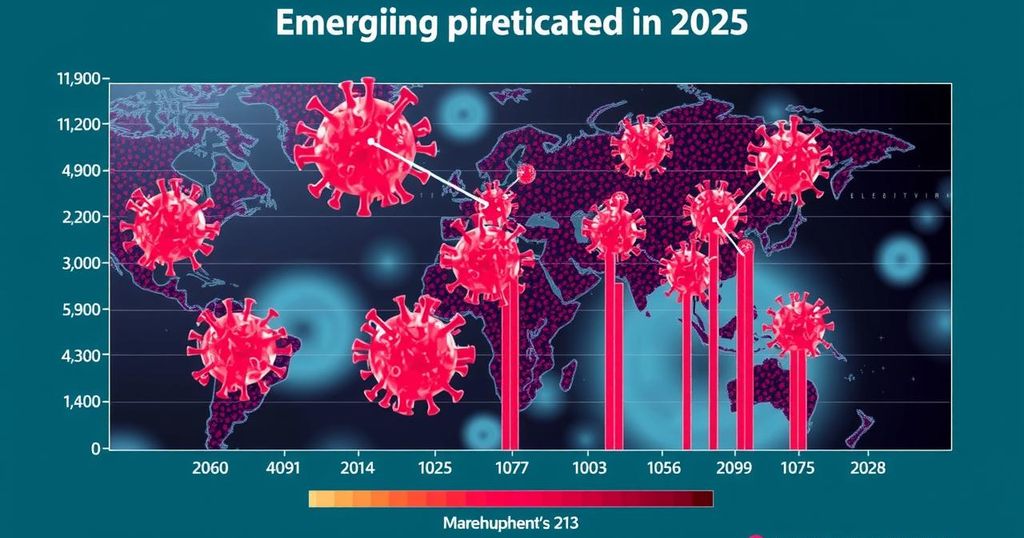Emerging Pathogens and the Threat of Future Pandemics: Insights for 2025

The UNEP has warned of a potential pandemic by 2030 due to emerging pathogens, particularly H5N1 influenza, which is one mutation away from human transmission. In 2024, outbreaks of zoonotic diseases and antimicrobial resistance are severe. The report highlights the impact of environmental factors and the need for global preparedness to confront the increasing risk of infectious diseases.
The United Nations Environmental Programme (UNEP) has released a report emphasizing the likelihood of the next pandemic emerging by 2030, primarily due to the proximity of new pathogens to human populations. Notably, the highly pathogenic avian influenza H5N1 has exhibited signs of potential human-to-human transmission. The year 2024 has witnessed various outbreaks of zoonotic diseases, including cholera, mpox, marburg, and oropouche fever, with the World Health Organization (WHO) confirming that at least 16 viral and bacterial outbreaks have occurred globally this year.
Simultaneously, the escalating crisis of antimicrobial resistance (AMR) remains a significant concern, particularly in light of the enduring impacts of the COVID-19 pandemic. The WHO has been engaged in discussions regarding the International Treaty on Pandemic Prevention, Preparedness and Response since 2021, yet gaps in global collaboration and readiness persist. UNEP’s report cautions that emerging zoonotic diseases could catalyze a pandemic by 2030, exacerbated by factors such as deforestation, urbanization, and unsustainable agricultural practices, with predictions indicating that fatalities could rise up to twelvefold by 2050 compared to 2020 levels.
In Africa, the mpox virus has exhibited increased virulence, with Clade 1b reported to have spread rapidly since its detection in the Democratic Republic of Congo in September 2023. This outbreak has resulted in approximately 50,000 cases and over 1,000 reported deaths and has since expanded to neighboring nations and other travels. By August 2024, WHO classified this as a public health emergency of international concern.
In Latin America, unprecedented rates of vector-borne diseases such as dengue and chikungunya are reported, particularly in Brazil, where over six million suspected dengue cases have emerged. The rising temperatures and precipitation have favored mosquito populations, leading to further expansion of these diseases into Europe, notably through Aedes albopictus, which has now established itself in multiple EU countries.
Compounding issues in North America include the spread of H5N1 influenza from birds to livestock, notably affecting 16 states and resulting in at least 65 human infections, highlighting worries about viral mutations and adaptability. In response to the alarming rate of PMR, the UN has ratified a political declaration aimed at reducing the estimated 4.95 million deaths associated with bacterial AMR, committing to a 10% annual reduction by 2030.
The looming threat of emerging infectious diseases due to environmental factors, coupled with the increasing incidence of antimicrobial resistance, presents significant risks to global health. Various international organizations, including UNEP and WHO, emphasize the need for comprehensive strategies to combat these challenges. The developing understanding of zoonotic diseases, those that jump from animals to humans, underscores the direct connection between human behavior, environmental health, and the potential for pandemics. Measures for preparedness and response have been acknowledged but require robust implementation and international cooperation to ensure efficacy against future outbreaks.
In summary, the warnings from the UNEP regarding the potential for a new pandemic by 2030 call for urgent attention to emerging pathogens and antimicrobial resistance. The vital role of environmental factors in facilitating disease outbreaks cannot be overlooked. As zoonotic diseases continue to resurface globally, coordinated international efforts and proactive health governance are imperative to mitigate these risks and protect human health in the years to come.
Original Source: www.downtoearth.org.in






